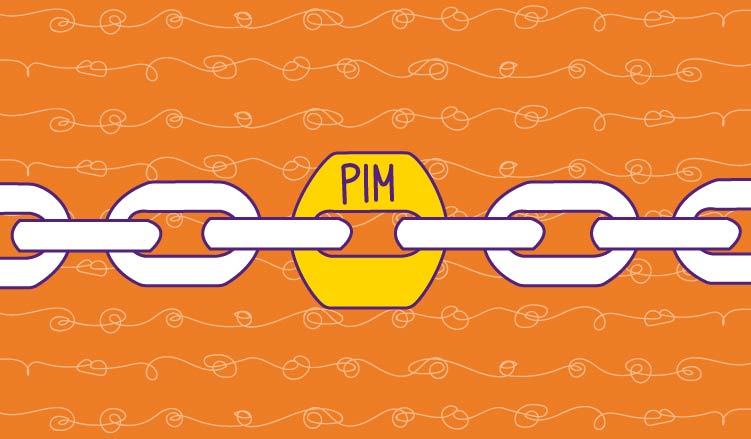To say the COVID-19 pandemic had—and still has—the world running around like headless chickens would be putting it lightly. It feels like the impact of this historical disaster is never-ending. And now thanks to the global supply chain disruption, it's not. (This is just one example of the issues being faced worldwide.)
According to CNBC, the supply chain issue is going to get worse before it gets any better. So, considering that we’re approaching the busiest time of the year, it’s safe to say the ecommerce industry will start to feel the heat soon. To ensure your customers are left satisfied, you need a resilient supply chain. And what’s a supply chain without product information management? Incomplete, if you ask us.
What’s the purpose of PIM?
Product information software in ecommerce is typically used to help businesses manage, organize, and store their data in a centralized place. This ensures businesses send accurate content internally and externally. The slightest error can directly impact sales, and studies have shown that incorrect information is the main cause of order returns, cart abandonment, and brand distrust.
But, the purpose of automating your product information goes far beyond ensuring ecommerce success but ensures you create a system that works regardless of what may come your way. In this case, it’s a supply chain disruption.
If you’re working in spreadsheets, Dropbox, or any old storage data unit, it’s time to start automating your data with PIM for supply chain management. It would help if you had a tool to improve the quality of data so that your supply chain has accurate data and reduces inaccuracies that can break the supply chain process.
Here’s how a PIM can strengthen your supply chain strategy
1. Frees up time so your team can strategize
To mitigate a crisis, you will need to be able to come up with a strategy that is best for your business. But, how will you and your team strategize and think on your feet when they’re drowning in large volumes of product data that need to be regularly updated, managed, and organized manually on Excel spreadsheets?
Your team cannot be spending more time on product data management than they need to, especially now. And, according to a report done by The State of Data Science and Analytics, employees without automated systems spend:
- 36 hours on data-related activities alone in a week
- 44% of employee workday is spent on unsuccessful data activities
The same report then goes on to say that employees are struggling with data management because they have to manually update formulas, tables, and spreadsheets. This causes a drop in productivity, which will slow down an already strained system. Your team needs to have their product information in one place so that they can address queries, figure out better approaches, work faster to get the product to the market, and help drive real-time sharing of information.
With a collaborative PIM tool, your employees can work faster on data management and focus more on ensuring product information is sent to manufacturers, wholesalers, and distributors faster, while also ensuring all customers are kept updated on their order queries or any delays.
2. Creates a robust inventory management system
To build a resilient strategy, your inventory management needs to be fail-proof. You need to have a full 360-degree view of how your stock is looking and efficiently plan to ensure you don’t end up understocked, overstocked, or have any deadstock that will sit around and take up space but not bring in sales. While you may want to stock more than you need to in panic, stocking on what you don’t need, and not having enough space for what you do need, won’t help you at all.
You need to:
- Set minimum stock levels, so you know when to order before you run out
- Understand all the links in your supply chain so you can stay ahead of issues
- Keep tabs on what’s not moving in your stock list and put it on sale to free up space for your most popular items. Prioritizing SKUs and findings ways to manage your content is key in ensuring you order what you need
- Try the safety stock approach where you have a minimum amount of inventory on hand as an emergency cushion to compensate for demand surges or supply shortages
Adding PIM to your ERP and inventory management software will help you bulk up your efforts. It can help you further automate your inventory processes through updates, tracking changes, correcting errors, approving changes, and efficiently forecasting for when you’ll need more stock.
3. Improves supply chain transparency
In times of disruption and uncertainties, having transparency and being on the same page with all parties is vital. Especially across supply chains. Inadequate communication and transparency can lead to one of the major issues supply chain managers face today which is untimely deliveries. According to a report done by EPS News, poor communication and supply chain disruptions cost one out of every three businesses about $1 million or more per year in losses. (This was before the pandemic—so imagine how much it costs organizations now!)
Having a PIM tool offers you a single source of truth where you can share content with all stakeholders in the supply chain. This ensures visibility across the entire supply chain. In real-time, having this clarity helps you avoid further disruptions and issues being resolved proactively rather than once the damage is done.
4. Ensures better forecasting
When it comes to forecasting product demand, the stakes are high. Better forecasting can help your organization avoid unnecessary costs, ensure you have the products your customers need, and ensure sales growth in the midst of chaos.
According to an article on Forbes:
“Forecasting tools are falling apart as they can’t keep up with the shifting demands of a highly interconnected global economy. We saw it with the toilet paper shortage, but it's not just Covid-19 that will throw us for a loop. This current year is sure to present similar challenges if companies continue to couple stale data and rigid assumptions with old-fashioned forecasting methods and tools.”
Instead, you need accurate, updated, and dynamic data to improve supply chain forecasting. And how can you get this? With a next-generation PIM system.
Errors generally occur during forecasting when:
- Product information isn’t easily available or accessible
- Doesn’t exist on the shelf
- There is incorrect product information
All these issues can be fixed with a product information management system.
Finding a PIM that’s suitable for your needs
There are many PIMs; you just need to find one that is suitable for your needs.
Each business is different, and to a certain extent, the same is said for a PIM tool. Their core features differ from being able to handle large numbers of SKUs, integrate with marketplaces, and effectively manage product information.
You need to look at:
- A PIM you can afford
- Whether you want an on-premise or Saas Cloud-based PIM
- Its flexibility and ease of use
- How well it integrates with your existing software
- The ease of product data importing
- Bulk editing and collaboration capabilities
Get Plytix PIM for free
We are confident that the Plytix PIM is the PIM tool you need to build a resilient supply chain. Plytix offers the best priced Saas-based cloud PIM for small businesses. It is easy to use, perfect for any sized team, and it is a collaborative tool that ensures you no longer work in silos but as a team with the same goal.
Our tool easily integrates with existing software such as ERPs, CRMs, and more. For more information on why you need a PIM solution right now, read our free whitepaper on How PIM Adopters Are Outperforming the Competition.




